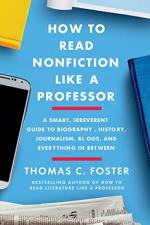
|
| Name: _________________________ | Period: ___________________ |
This quiz consists of 5 multiple choice and 5 short answer questions through Section 3: Chapter 9, "Living the News" through Chapter 12, "That Is So Last Year".
Multiple Choice Questions
1. In Chapter 10, "From the Inside Out," which writer does Foster credit with originating the essay?
(a) Rene Descartes.
(b) George Orwell.
(c) Michel de Montaigne.
(d) Virginia Woolf.
2. In Chapter 7, "All in How You Look at Things," Foster says that which type of nonfiction is usually better off starting at the beginning chronologically?
(a) Philosophy.
(b) Reportage.
(c) History.
(d) Biography.
3. In Chapter 10, "From the Inside Out," what aspect of Renaissance scholarship does Foster say the essay rebels against?
(a) Respect for accurate history.
(b) The importance of institutional authority.
(c) Obedience to the Christian God.
(d) The veneration of classical Greece and Rome.
4. In Chapter 6, "Source Code," what does Foster say is an advantage of using data as evidence?
(a) It exists independent of our will and beliefs.
(b) It is one of the only sources that people still believe in.
(c) It can be manipulated to make it say what the author wants it to say.
(d) The reader often isn't aware of whether the data is real or not.
5. In Chapter 6, "Source Code," where does Foster suggest writers should gather information about historical figures?
(a) Newspaper archives.
(b) History books.
(c) Biographies.
(d) Primary sources.
Short Answer Questions
1. Based on Chapter 2, "The Ecology of the Nonfiction Biosphere," how would Foster sum up the place of newspapers in today's world?
2. According to Chapter 8, "Bringing the News," at what level are most news stories written?
3. In Chapter 2, "The Ecology of the Nonfiction Biosphere," Foster notes that the expectation for a writer to be engaging does not apply to which types of writing?
4. Whose Apologia Pro Vita Sua is discussed in Chapter 11, "Life from the Inside"?
5. In Chapter 7, "All in How You Look at Things," what does Foster say the term "Fake News" originally referred to?
|
This section contains 377 words (approx. 2 pages at 300 words per page) |

|




